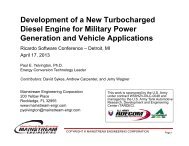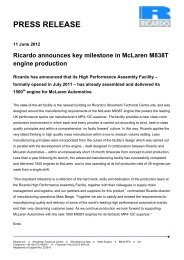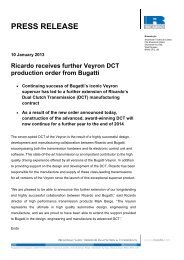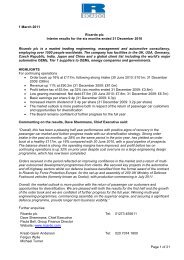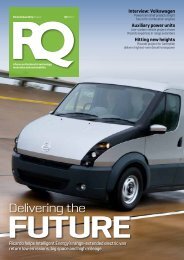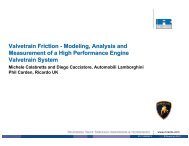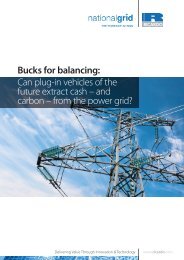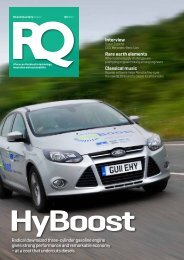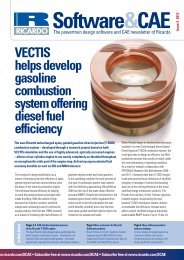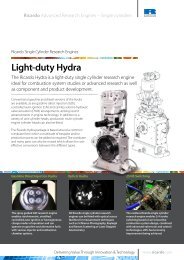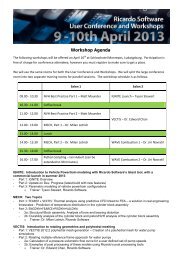Case Study - Ricardo
Case Study - Ricardo
Case Study - Ricardo
You also want an ePaper? Increase the reach of your titles
YUMPU automatically turns print PDFs into web optimized ePapers that Google loves.
<strong>Case</strong> <strong>Study</strong>
2/4 SIGHT<br />
Stroke of<br />
genius for gasoline<br />
downsizing<br />
Against the backdrop of spiralling gasoline pump<br />
prices, a revolutionary new engine concept<br />
developed by a consortium led by <strong>Ricardo</strong><br />
offers an attractive alternative to conventional<br />
spark ignited combustion. The 2/4SIGHT engine<br />
presents the prospect of 27 per cent fuel savings<br />
compared with current engine technology by<br />
combining the benefits of two- and four-stroke<br />
combustion, as Anthony Smith reports<br />
Engine downsizing has long been<br />
acknowledged as an important<br />
route to the improvement of fuel<br />
economy. All else being equal, a smaller<br />
engine has less internal friction so that<br />
less energy is wasted merely in turning<br />
its internal components. It also has<br />
less thermal inertia, which means that<br />
it warms up more quickly and is thus<br />
more thermally efficient in a typical<br />
mixed-duty, real-world operation.<br />
Moreover, as most car engines<br />
operate at well below their point of<br />
peak efficiency in day-to-day use, by<br />
substituting a smaller capacity unit<br />
operating at higher specific load the<br />
combustion and gas exchange process<br />
can be more efficient.<br />
To deliver the same performance as<br />
a larger engine, however, a downsized<br />
unit must employ charge air boosting<br />
either in the form of turbocharging or<br />
supercharging. While these measures<br />
clearly give rise to some product cost<br />
implications, the resulting higher cycle<br />
efficiency and lower friction can offer<br />
much sought-after fuel economy and<br />
CO2 emissions improvements.<br />
Nevertheless, there are also some<br />
very practical limits to downsizing in a<br />
conventional four-stroke engine. The<br />
main obstacle to downsizing is the<br />
achievement of good low-speed torque<br />
and launch feel. The boost system<br />
applied to a downsized engine will<br />
produce more torque, but this is limited<br />
Source: US Government Energy Information Administration<br />
400<br />
350<br />
300<br />
250<br />
200<br />
150<br />
100<br />
50<br />
0<br />
Retail price of gasoline – cents per US Gallon<br />
2000 2001 2002 2003 2004 2005 2006 2007 2008<br />
With fuel prices on the increase<br />
(left) the 2/4SIGHT is an attractive<br />
engine technology. The first research<br />
prototype (main picture) was installed<br />
at the Sir Harry <strong>Ricardo</strong> laboratory of<br />
the University of Brighton.<br />
8 RICARDO QUARTERLY REVIEW • Q3, 2008
“When we first<br />
conceived the<br />
2/4SIGHT engine<br />
we realised that we<br />
could potentially<br />
overcome the<br />
compression ratio<br />
barrier to further<br />
downsizing ”<br />
Professor Neville Jackson,<br />
<strong>Ricardo</strong> group<br />
technology director<br />
by the onset of abnormal combustion<br />
as higher pressures and temperatures<br />
are reached; this is a problem<br />
particularly pronounced at lower<br />
engine speeds. High cylinder pressures<br />
require larger connecting rod and crank<br />
bearings to accommodate the increase<br />
in load. This in turn can increase friction<br />
such that the benefits of downsizing<br />
can be significantly reduced. To operate<br />
successfully, highly boosted four-stroke<br />
engines must therefore use a lower<br />
static compression ratio, which then<br />
reduces efficiency and negates the<br />
benefits of any further downsizing.<br />
Launch feel can also be a challenge<br />
for turbocharged engines due to the<br />
finite time required to accelerate the<br />
turbocharger from idle to generate<br />
boost pressures. Mechanically driven<br />
superchargers can help to resolve this<br />
issue but these devices also increase<br />
losses and reduce efficiency.<br />
Taking downsizing one step further<br />
Hybridisation, in effect using electric<br />
power to augment low-end torque, is<br />
a well proven route to enabling further<br />
levels of downsizing. But while this<br />
approach works successfully in many<br />
products, it brings significant additional<br />
cost and complexity in the shape of the<br />
hybrid powertrain, power electronics<br />
and energy management systems.<br />
An ideal solution to the twin obstacles<br />
to aggressive downsizing – low speed<br />
torque performance and high specific<br />
power combustion stability – would<br />
be a solution internal to the engine<br />
Q3, 2008 • RICARDO QUARTERLY REVIEW 9
2/4 SIGHT<br />
and hence not requiring additional<br />
systems. This was a challenge which<br />
had occupied the engineers of <strong>Ricardo</strong>’s<br />
technology group for some years.<br />
However, in 2004 <strong>Ricardo</strong> decided that a<br />
combustion system initially developed<br />
by the company in the late 1980s might<br />
offer a solution.<br />
Flagship technology<br />
Over fifteen years ago <strong>Ricardo</strong> had<br />
demonstrated a poppet-valve twostroke<br />
engine concept known as<br />
the ‘Flagship’ engine; the concept<br />
was intended for premium vehicle<br />
applications where a higher performing<br />
premium vehicle two-stroke engine<br />
could be used within the same basic<br />
architecture as a more basic four-stroke<br />
used for lower performance vehicle<br />
derivatives.<br />
The concept was demonstrated<br />
successfully as both single and multicylinder<br />
demonstrator engines but<br />
research was curtailed when it became<br />
clear that its commercial application<br />
would be limited. Yet there were<br />
aspects of the Flagship combustion<br />
technology which have since made<br />
their way into successful conventional<br />
engines. The engine had achieved its<br />
scavenging performance through the<br />
use of a top entry intake port geometry<br />
which, combined with port shielding,<br />
created a reverse tumbling motion on<br />
induction. This same <strong>Ricardo</strong>-patented<br />
system has since found application in<br />
a number of direct injection gasoline<br />
engines where it is a well proven<br />
enabler of stratified combustion.<br />
Two into four does go<br />
In something of a eureka moment,<br />
engineers in the <strong>Ricardo</strong> technology<br />
group realised that the intake and<br />
combustion chamber geometry<br />
originally developed for Flagship could<br />
be used as the basis of an engine<br />
capable of operating in either two- or<br />
four-stroke modes. The new concept,<br />
named 2/4SIGHT, offered some<br />
immediate and attractive benefits<br />
for the challenge of gasoline engine<br />
downsizing.<br />
“When we first conceived the<br />
2/4SIGHT engine we realised that<br />
we could potentially overcome the<br />
compression ratio barrier to further<br />
downsizing,” explains <strong>Ricardo</strong> group<br />
technology director, Professor Neville<br />
Jackson. “By running the engine in<br />
two-stroke mode under low-speed/<br />
high-load conditions, the torque<br />
produced by each cylinder every power<br />
stroke is about half of that which would<br />
need to be produced by a four-stroke<br />
engine under the same duty. This<br />
means that the engine can retain a<br />
high compression ratio and would<br />
not require an increase in crank and<br />
rod bearing sizes. This configuration<br />
can deliver higher efficiencies than a<br />
boosted four-stroke engine with similar<br />
torque and power output. Two-stroke<br />
operation effectively offers a means<br />
of boosting low-end performance,<br />
in the process further increasing the<br />
opportunity for downsizing in spark<br />
ignition engines. The main benefit<br />
to the driver would be reduced fuel<br />
consumption and, possibly, better<br />
launch feel.”<br />
The 2/4SIGHT engine would start in<br />
exactly the same manner as a typical<br />
four-stroke direct injection gasoline<br />
car engine. Its control system would<br />
monitor driver demand and when<br />
more torque is required than would<br />
be possible in four-stroke mode,<br />
the fuelling, air handling and valve<br />
train would be adjusted to enable<br />
switching within a single cycle and<br />
on an individual cylinder basis so that<br />
torque delivery remains smooth and<br />
uninterrupted as the engine switches<br />
between modes. Only the engine note<br />
would change due to the different firing<br />
frequency, much as in the sound made<br />
during a transmission downshift.<br />
CAE concept simulation study<br />
In 2004 part funding was made<br />
available under the UK government’s<br />
Foresight Vehicle programme for<br />
<strong>Ricardo</strong> and a consortium including<br />
two leading UK Universities – Brunel<br />
and Brighton – as well as a number<br />
of auto industry partners, to embark<br />
How the 2/4SIGHT concept works: Two-stroke mode<br />
In two stroke mode the 2/4SIGHT concept works by using boost air to scavenge the cylinder during a prolonged period of valve<br />
overlap. The geometry of the vertical intake port and valve shrouding in the combustion chamber promotes a reverse tumbling<br />
motion on induction. This flow structure is particularly effective in promoting efficient scavenging.<br />
10 RICARDO QUARTERLY REVIEW • Q3, 2008
Lower<br />
Compression<br />
ration<br />
▲<br />
Low Speed<br />
Ignition<br />
Retard<br />
▲<br />
High Octane<br />
Requirement<br />
▲<br />
▲<br />
Improved<br />
Economy<br />
Vicious<br />
Circle<br />
▲<br />
upon a simulation-led concept study<br />
to evaluate the 2/4SIGHT concept.<br />
This work involved the development<br />
of the design of the engine and air<br />
handling systems, one dimensional<br />
gas dynamics and performance<br />
simulation using the <strong>Ricardo</strong> WAVE<br />
software, three-dimensional CFD of the<br />
combustion system using VECTIS, as<br />
well as vehicle simulation using a range<br />
of proprietary and industry standard<br />
modelling tools. At this stage details of<br />
valve train actuation and control system<br />
architecture and strategies were put<br />
to one side: the main objective was to<br />
prove that the concept had the potential<br />
to deliver the desired breakthrough in<br />
downsizing.<br />
The concept study provided<br />
extremely promising results: simulation<br />
showed that by optimising the<br />
performance of the engine and using<br />
two-stroke operation in particular for<br />
low speed, high torque operation,<br />
substantial fuel savings were possible<br />
in comparison with conventional<br />
production four-stroke engines.<br />
Moreover, it showed the combustion<br />
system could operate effectively during<br />
transition between two- and four-stroke<br />
modes of operation. The concept was<br />
shown to be particularly attractive for<br />
development towards the needs of<br />
mid-sized C-D segment cars and larger<br />
premium vehicles and SUVs, where<br />
performance is required but current<br />
▲<br />
High Cylinder<br />
Pressures<br />
Down-sizing<br />
▲<br />
▲<br />
Poor Low<br />
Speed torque<br />
Supercharging /<br />
Sequential Turbo<br />
High<br />
Compression<br />
ration<br />
Lower Octane<br />
Requirement<br />
Lower Cylinder<br />
Pressures<br />
Improved<br />
Economy<br />
Virtuous<br />
Circle<br />
2S Operation<br />
at High Torque<br />
Down-sizing<br />
Poor Low<br />
Speed torque<br />
Supercharging /<br />
Sequential Turbo<br />
products have comparatively high fuel<br />
consumption.<br />
Unusually for an engine which<br />
has been tested and evaluated only<br />
in the domain of computer-aided<br />
engineering models, the 2/4SIGHT<br />
concept was taken up enthusiastically<br />
by the media. This interest culminated<br />
in late 2004 with the award to <strong>Ricardo</strong><br />
of the Autocar magazine Safety and<br />
Technology trophy for the company’s<br />
work on 2/4SIGHT.<br />
Building the first prototype<br />
In early 2005, building on the very<br />
promising results of the concept study,<br />
a further programme was initiated<br />
aimed at delivering the world’s first<br />
switchable two- four-stroke engine<br />
in prototype form. With design and<br />
Gasoline engine downsizing is effectively<br />
limited by compression ratio and low<br />
speed torque performance. The 2/4SIGHT<br />
concept overcomes these obstacles,<br />
enabling more aggressive downsizing and<br />
hence substantial fuel savings without<br />
compromising performance.<br />
prototype manufacturing carried out<br />
at <strong>Ricardo</strong>, a multi-cylinder research<br />
prototype engine would be tested at<br />
the Sir Harry <strong>Ricardo</strong> laboratories of<br />
the University of Brighton. This engine<br />
was based on a single bank of a 2.1<br />
litre V6, which in six-cylinder 2/4SIGHT<br />
configuration would be intended to<br />
deliver levels of performance and<br />
driveability more usually associated<br />
with a three- to four-litre V8 gasoline<br />
engine. In parallel with the prototype<br />
development work, a single cylinder<br />
Hydra research engine was used at<br />
Brunel University in order to develop<br />
the combustion and control systems.<br />
As this was a fundamentally new<br />
engine concept it was essential that<br />
the prototype would enable a wide<br />
range of control strategies to be<br />
evaluated for switching between<br />
two- and four-stroke modes. As<br />
such it was important therefore that<br />
no physical constraints should be<br />
placed on valve actuation during the<br />
test programme. In order to enable<br />
the project team to assess control<br />
strategies in a completely unrestricted<br />
How the 2/4SIGHT concept works: Four-stroke mode<br />
In four-stroke mode the engine operates in exactly the same manner as a boosted gasoline DI. The ability to switch smoothly<br />
between modes on an individual cylinder basis enables highly aggressive downsizing as two-stroke operation is used for low<br />
speed, high load operation.<br />
Q3, 2008 • RICARDO QUARTERLY REVIEW 11
2/4 SIGHT<br />
The 2/4SIGHT concept relies on an intake<br />
and combustion chamber geometry capable<br />
of operatiing in both two-and-four-stroke<br />
modes (left and below). A mechanical<br />
valve switching system (below right) has<br />
been designed for use in future vehicle<br />
applications.<br />
the rig and had full confidence in the<br />
simulation work on which the design<br />
was based. Nonetheless, the team had<br />
an immense sense of achievement<br />
when we successfully achieved the<br />
world’s first firing of such a switchable<br />
engine”.<br />
“To put this into perspective, in two-stroke<br />
mode the test bed engine has achieved<br />
over 230 Nm per litre. This enables a twolitre<br />
switching engine to achieve over 450<br />
Nm, which is similar to a 4.5 litre naturally<br />
aspirated four-stroke engine”<br />
Dr Tim Lake, 2/4Sight chief engineer<br />
manner, an electro-hydraulic valve<br />
(EHV) actuation system was used<br />
for the prototype development rig.<br />
While this configuration was ideal<br />
for research purposes it was never<br />
intended as a practical solution for<br />
in-vehicle use. Instead, a more simple<br />
mechanical switching system would<br />
be implemented once the desired<br />
strategies had been evaluated.<br />
In parallel with the prototype engine<br />
development effort in the UK, <strong>Ricardo</strong><br />
engineers at the company’s Detroit<br />
Technology Campus undertook a<br />
study which led to the creation of a<br />
patented mechanical cam switching<br />
system which would be capable of<br />
delivering the required valve switching<br />
performance for the control strategies<br />
developed on the prototype engine with<br />
its EHV system. This not only opens the<br />
way for packaging and integration of<br />
the 2/4SIGHT engine into a production<br />
vehicle but also represents a very costeffective<br />
means of implementation<br />
of this highly efficient combustion<br />
concept.<br />
The air handling system of the<br />
2/4SIGHT concept is based on twostage<br />
boosting and intercooling using<br />
a Rotrex supercharger and Honeywell<br />
turbocharger. For simplicity in the<br />
initial test bed prototype configuration,<br />
however, boosting was provided by an<br />
external compressed air supply. The<br />
engine control system of the prototype<br />
was a DENSO rapid prototyping system<br />
working with DENSO gasoline direct<br />
injection and ignition components.<br />
First ‘switchable’ fire<br />
In late 2007 testing commenced on the<br />
prototype engine. As senior project<br />
engineer Richard Osborne explains, the<br />
achievement of first switchable firing<br />
was a major achievement for the project<br />
team: “In normal circumstances the<br />
first firing of any research prototype<br />
engine is a major milestone in itself. For<br />
2/4SIGHT we had three such hurdles to<br />
achieve: operation separately in twoand<br />
four-stroke modes and switching<br />
under firing conditions between<br />
modes. We had already proven the<br />
mechanical and air handling aspects of<br />
Automatic switching algorithm<br />
development<br />
For the 2/4SIGHT engine concept<br />
to be successful it is essential that<br />
switching is entirely demand-driven<br />
and is fully automatic. For all normal<br />
driving conditions and moderate<br />
acceleration, the engine should<br />
operate as a conventional four-stroke.<br />
Typically, two-stroke operation would<br />
be solely used when low-speed/high<br />
torque is required. This requires the<br />
control system to initiate switching<br />
purely based on the required duty,<br />
and to implement it in such a manner<br />
that the rate of change of torque is not<br />
interrupted in any way.<br />
Mode-switching development was<br />
carried out in simulation in the first<br />
instance, using a transient model<br />
created in the MATLAB-Simulink<br />
environment with an embedded<br />
WAVE engine model incorporating<br />
the turbocharger and supercharger.<br />
This enabled automatic generation of<br />
the required valve timings and lifts to<br />
be used in the EHV system of the test<br />
xxxxxx<br />
12 RICARDO QUARTERLY REVIEW • Q3, 2008
ed engine, as well as development of<br />
the transient fuelling, spark timing and<br />
boost strategies. The key to success has<br />
been the systematic co-ordination of all<br />
these parameters during switching, a<br />
very challenging task.<br />
The prototype engine performed<br />
faultlessly in the subsequent<br />
development programme, validating<br />
both the switching strategies through<br />
demonstration of a wide range of<br />
constant torque and load transients,<br />
and also the performance of the<br />
aggressively downsized engine in both<br />
two- and four-stroke operation.<br />
Vehicle simulation based on<br />
engine tests<br />
Having validated the basic engine<br />
concept, the research team went on to<br />
assess the fuel economy improvement<br />
potential of the 2/4SIGHT engine<br />
through vehicle drive cycle and<br />
acceleration performance simulation.<br />
This work was based on the measured<br />
steady state fuel consumption and full<br />
load performance of the prototype<br />
2/4SIGHT engine and was carried<br />
out using the <strong>Ricardo</strong><br />
powertrain blockset in the<br />
MSC “EASY5” software<br />
package, which allows<br />
detailed modelling of<br />
engines, transmissions,<br />
drivelines, tyres and<br />
aerodynamics. The<br />
baseline vehicle<br />
for the study<br />
was an 1800 kg<br />
passenger car<br />
sold in the European<br />
market with a 3.5<br />
litre naturally aspirated V6 gasoline<br />
engine and five-speed conventional<br />
automatic transmission with torque<br />
converter. To verify the validity of the<br />
models and input data, the baseline<br />
vehicle fuel consumption results were<br />
compared with published data, which<br />
were reproduced by the model to an<br />
acceptable accuracy of 1 per cent.<br />
The simulation results indicate that<br />
vehicle acceleration performance,<br />
including launch from rest, can be<br />
maintained with a 2.1 litre V6 2/4SIGHT<br />
gasoline engine replacing the 3.5 litre<br />
baseline powerplant. This would deliver<br />
fuel savings of 27 per cent over the<br />
New European Drive Cycle (NEDC)<br />
and would reduce the vehicle CO2<br />
emissions of the baseline from 260<br />
grams per kilometre to 190 g/km.<br />
Dr Tim Lake, 2/4Sight chief engineer<br />
and veteran of the original Flagship<br />
studies, emphasises the full extent<br />
of the achievement that these results<br />
represent: “To put this into perspective,<br />
in two-stroke mode the test bed engine<br />
has achieved over 230 Nm per litre. This<br />
The 2/4SIGHT consortium<br />
<strong>Ricardo</strong>:<br />
Project leader and coordinator.<br />
Responsible within the project for the<br />
design, simulation and development of<br />
the prototype engine and integration<br />
of its systems. In parallel with the<br />
project <strong>Ricardo</strong> also designed the<br />
mechanical switching system to be<br />
used in the 2/4CAR vehicle project.<br />
DENSO:<br />
Responsible for development and<br />
supply of the direct fuel injection and<br />
advanced engine control systems.<br />
Ma 2T4:<br />
Contributed its knowledge and<br />
expertise of valvetrain switching<br />
technology.<br />
Brunel University:<br />
Carried out single-cylinder engine<br />
testing and development.<br />
The University of Brighton:<br />
Carried out multi-cylinder engine<br />
testing and combustion and cooling<br />
system analysis.<br />
The 2/4SIGHT project was partfunded<br />
by the UK Government<br />
through the Technology Strategy<br />
Board. The Board’s mission is to<br />
promote and support research into,<br />
and development and exploitation<br />
of, technology and innovation for<br />
the benefit of UK business, in order<br />
to increase economic growth and<br />
improve the quality of life.<br />
Q3, 2008 • RICARDO QUARTERLY REVIEW 13
2/4 SIGHT<br />
“We aim to draw on the lessons of the<br />
2/4SIGHT research prototype engine<br />
programme and use this to create a design<br />
which can be packaged in a contemporary<br />
luxury vehicle” Professor Neville Jackson,<br />
<strong>Ricardo</strong> group technology director<br />
enables a two-litre switching engine to<br />
achieve over 450 Nm, which is similar to<br />
a 4.5 litre naturally aspirated four-stroke<br />
engine. As such, the simulation shows<br />
that torque performance is significantly<br />
improved over the baseline vehicle –<br />
and yet it still delivers a 27 per cent fuel<br />
economy improvement.”<br />
2/4SIGHT Vehicle programme<br />
announced<br />
The highly impressive results of the<br />
development testing of the 2/4SIGHT<br />
research prototype engine attracted<br />
widespread media attention following<br />
their release in late March of this year.<br />
Less than two months later this was<br />
followed by the announcement from the<br />
UK government’s Technology Strategy<br />
Board that, as part of a £23 million<br />
funding programme for innovative<br />
low carbon vehicle development<br />
projects, it was to provide support to<br />
take the concept forward to a vehicle<br />
demonstration programme.<br />
Building on the work of the 2/4SIGHT<br />
engine concept, the 2/4CAR project<br />
aims to deliver a global premium<br />
vehicle demonstrator which will<br />
realise the promise of the engine<br />
programme. The publicly quoted<br />
targets remain challenging: a 25 to 30<br />
per cent reduction in carbon dioxide<br />
emissions with no loss of performance,<br />
through the use of a 2/4SIGHT engine<br />
to substitute for a baseline engine of<br />
approximately twice its capacity.<br />
“We aim to draw on the lessons<br />
of the 2/4SIGHT research prototype<br />
engine programme and use this to<br />
create a design which can be packaged<br />
in a contemporary luxury vehicle,”<br />
explains Jackson. “This will incorporate<br />
a development of the patented<br />
Demonstration of mode switching under<br />
constant torque (left). Performance<br />
comparison with baseline (right), and fuel<br />
economy results (below)<br />
mechanical switching technology<br />
developed in parallel with the engine<br />
prototype project in order to realise<br />
the switching strategies previously<br />
demonstrated on the test bed.”<br />
<strong>Ricardo</strong> is to lead the 2/4CAR<br />
project and will work together with a<br />
consortium of partners also including<br />
the University of Brighton, DENSO<br />
Sales UK Ltd and Jaguar Cars Ltd. If<br />
the results of the vehicle demonstrator<br />
programme live up to the great promise<br />
revealed by the research prototype<br />
engine development programme just<br />
completed, the switchable 2/4SIGHT<br />
engine concept could be extremely<br />
attractive to both automakers and the<br />
driving public in the new paradigm of<br />
high fuel prices and stretching CO2 and<br />
fuel economy targets.<br />
2/4SIGHT FUEL ECONOMY<br />
RESULTS<br />
Published Data<br />
Simulation<br />
Baseline Baseline 2/4SIGHT Delta %<br />
ECE fuel L/100km 15.5 15.8 10.1 -36.1<br />
EUDC fuel L/100km 8.3 8.2 6.7 -18.4<br />
NEDC fuel L/100km 11.0 11.0 7.9 -27.7<br />
NEDC CO2 fuel L/100km 260 257 186 -27.7<br />
14 RICARDO QUARTERLY REVIEW • Q3, 2008



